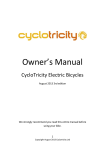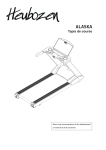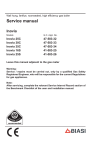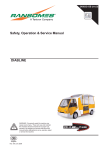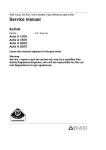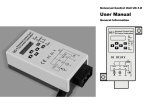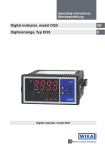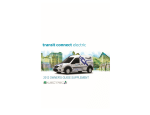Download Scoot'elec User Manual
Transcript
Scoot'elec User Manual CONTENTS Contents .......................................................................................................................................................... 1 Introduction ...................................................................................................................................................... 2 Safety advice ..............................................................................................................................................2 - 3 Presentation..................................................................................................................................................... 4 Driving.............................................................................................................................................................. 4 Driving battery.................................................................................................................................................. 5 Battery charging............................................................................................................................................... 6 Battery maintenance........................................................................................................................................ 7 Anti-theft advice ............................................................................................................................................... 8 Braking............................................................................................................................................................. 8 Operating instructions..................................................................................................................................... 9 Driver's cockpit .............................................................................................................................. 10 Instrument panel.............................................................................................................................11-12 Start checks ......................................................................................................................................... 13 Starting................................................................................................................................................. 13 Driving modes...................................................................................................................................... 14 Parking................................................................................................................................................. 14 Kill switch ............................................................................................................................................. 15 Steering anti-theft protection ............................................................................................................... 15 Housing for demi-jet helmet ................................................................................................................ 15 Seat...................................................................................................................................................... 16 Lighting and indicators .................................................................................................................16 - 17 Maintenance and adjustments .............................................................................................. 17 -18 - 21 Coded anti-start : changing the code .................................................................................................. 19 Technical specifications ............................................................................................................................... 20 Maintenance plan ......................................................................................................................................... 21 1 mile 1 kilometre 1 livre 1 kilogramme = 1.6 kilometres = 0.62 miles = 0.45 kilogrammes = 2.2 livres ELMANANG.DOC 5/24/2003 1 Introduction This manual is your guide for driving, use and basic maintenance of your PEUGEOT electric Scooter. Your electric scooter has been given the name Scoot'elec, a name which embodies its international ambitions. Take the time to read this document carefully. As for all high technology machines, the care and attention with which you use and maintain your Scooter will guarantee problem-free driving and maximum performance. Your PEUGEOT MOTOCYCLES dealer is there to advise and inform you and his expertise is available for carrying out the maintenance of your vehicle and battery with care and to maintain them in perfect working order. Your PEUGEOT MOTOCYCLES Scoot'elec registered dealer knows all about the special features of your Scooter. He has all PEUGEOT original parts at his disposal as well as the special tooling for carrying out routine maintenance of your Scooter in the best conditions. We would like to thank you for having chosen PEUGEOT and guarantee that your electric scooter will give you many years of safe and happy transport. For now, we want to congratulate you for having the will to see things differently. Safety advice The safety of the vehicle depends on the care of the driver. High speed is a decisive factor in many accidents. Obey speed limits and never drive faster than safety conditions allow. Beware of the risk of slipping on road markings. Before use, always carry out a general check to make sure that the vehicle can be used in all safety. Road safety regulations mean that wearing a helmet is compulsory for the driver and passengers under fourteen. It is also recommended to wear gloves, eye protection and bright and visible clothing to increase your safety. A new electric scooter driver must familiarise himself with his vehicle before driving in traffic. Do not forget that your scooter does not make any noise due to its electric motor and therefore pedestrians are more likely to be taken unawares. BE DOUBLY CAREFUL Safety advice An electric scooter driver must inform other road users of his presence by : ELMANANG.DOC 5/24/2003 2 • avoiding driving in areas of non visibility for other drivers. • driving carefully at junctions, in car parks, at exits and slip roads. Your electric scooter is designed for urban use and for driving on road surfaces only. The baggage holders or bags available as options are designed for carrying light objects. Make sure that weight is evenly distributed and that any objects are firmly secured in place. Your scooter has been designed in accordance with legal requirements. Do not carry out any modifications on your electric scooter. Only use products which have been tested and recommended by PEUGEOT MOTOCYCLES. The scooter battery contains electrolyte; in the event of electrolyte getting on : • SKIN: rinse the affected area immediately, • EYES: rinse immediately and see a doctor. IMPORTANT When charging the battery, take all the normal precautions for electrical equipment. As a small amount of hydrogen is given off when charging the battery, make sure that the garage is adequately ventilated if carrying out this operation at home. The charger plug must be connected to a socket with standardised earth. No work must be carried out on the scooter if the charging plug is connected to the mains (no dismantling of caps or protections, no washing etc....). If work is absolutely necessary : • disconnect the charger from the mains to avoid the risk of electrocution. • disconnect the battery to avoid a short circuit which would cause irreparable damage to your Scoot'elec (first, remove the negative lead - identified by green marks). ELMANANG.DOC 5/24/2003 3 Presentation Your electric scooter is equipped with an 18 volt D.C. motor supplied by a traction battery (the term battery covers all the monoblocs), made up of three 6 volt CADMIUM - NICKEL type batteries. An electronic control unit (ECU) records, manages and checks the drivers commands, use of electric power and operational safety. An onboard charger allows the traction battery to be recharged. WARNING Do not fit any electric accessories (for example radio, CB or alarm) which have not been approved by PEUGEOT MOTOCYCLES as they could interfere with or damage onboard electronic systems. Furthermore, during charging interference could affect radios or television sets within a 2m radius around the scooter. If you fit a windscreen -pay attention do not cut or pinch a electric cable . Dismantle the head light to lock at the mounting of the windscreen Driving − Driving an electric scooter is similar to driving a combustion powered vehicle, but requires a few specific precautions and getting used to. − the maximum legal speed is 45km/h-28miles/h and the autonomy following a full charge gives approximately one hour's driving . To get the most out of your scooter's autonomy : − adopt a relaxed style of driving avoiding harsh braking. − to slow down, use the motor brake which can be obtained by releasing the accelerator handle; furthermore, this deceleration allows energy to be recovered. − make sure that tyres are at the right pressure (2.5 bars) and that the brake free travel is correctly adjusted (page 18). − preferably, carry out full charges, i.e., until the warning light goes out. ELMANANG.DOC 5/24/2003 4 Driving battery The NICKEL CADMIUM driving battery requires periodic maintenance signalled by the lighting up of the "maintenance" warning light on the instrument panel. This maintenance must be made two or three times a year This maintenance operation can only be carried out by a PEUGEOT MOTOCYCLES Scoot'elec registered dealer. During charging: Warning - no flames or sparks should be used near the battery due to a small amount of hydrogen being released. Battery electrolyte is a corrosive, alkaline solution. In the event of contact with the skin : wash immediately with water. In the event of contact with eyes : wash immediately with water and see a doctor. If liquid appears under the vehicle : dilute with water and sponge away wearing rubber gloves. Inform your PEUGEOT MOTOCYCLES dealer. Recycling of the three monoblocs making up the battery : At the end of their life, these monoblocs should be taken to a dealer's who will deal with recycling them. ELMANANG.DOC 5/24/2003 5 Battery charging Connect the charge lead plug (located under the seat) to a 230V - 10A/16A mains socket with earth and protected by differential circuit breaker of 30 mA. The charge light will light up on the instrument panel and a beep will be heard. As soon as maximum capacity is reached, charging is stopped automatically and the light Make sure the lead is replaced under the seat before using the vehicle. will go out. The use of an extension lead is not advised. If you have no other option, make sure a "STANDARDISED" extension lead is used, i.e., a lead which can withstand at least 10 Amps and has an earth wire. As the charge is controlled both in terms of time and temperature by the electronic control unit, it is not advised to use a programmer. Duration of complete charge (battery empty) approximately 5h. Note: If the temperature of the battery is high, charging will only begin after an automatically controlled cooling will period (resulting in charging time being increased by the same amount). The H warning light flash on and off until charging is started automatically. During charging, it is normal to witness a rise in temperature at the rear of the vehicle caused by the cooling fan. Do not obstruct the air outlet underneath the red light (no cover, no cagoule to dry....). Charging can be carried out at all times whatever is shown on the energy gauge or on the battery charge warning light (lit, off, flashing). Nevertheless, you are advised to carry out a full charge as regularly as possible (until the warning light goes out). If the vehicle is not used for more than a week, several "charging and discharging" cycles may be necessary for the full capacity of the battery to be reached. Once the charge is complete, the lead can remain connected up to the next time it is used. Rapid charge option A specific external charger is necessary in order to carry out this type of charge. The time saved compared to a normal charge is 50%. A PEUGEOT MOTOCYCLES dealer is at your disposal for fitting a special socket on your scooter and to supply you with this optional charger. In this case, your charging location must be equipped with two 230V 10A/16A sockets. Warning − During charging, it is prohibited to carry out any work on the vehicle. In particular: no washing, no dismantling, no movement (nor taking off stand). − charging must be carried out in a well ventilated room and away from flames or sparks due to a small amount of hydrogen being released. In particular : do not carry out charging in a boiler room or near to an electric switch. If liquid appears under the vehicle after charging, dilute with water and wipe away wearing compulsory rubber gloves. Inform your PEUGEOT MOTOCYCLES dealer. ELMANANG.DOC 5/24/2003 6 Battery maintenance This maintenance is to be carried out by a Scoot'elec registered dealer when the battery maintenance signals that it is necessary. warning light off off No maintenance necessary off slow flashing Maintenance to be planned in 150 to 200km - 90 to 120 miles depending on the type of use off rapid flashing Maintenance compulsory performance is dropping lit rapid flashing Maintenance compulsory vehicle blocked Only handling mode is possible (see page 14) Note : If you do not carry out this maintenance, the electronic safety function will gradually reduce performance until the scooter comes to a complete standstill. It will only start to function normally once this maintenance has been carried out. IMPORTANT The battery guarantee is subject to this maintenance being carried out correctly. A specific procedure and a product satisfying PEUGEOT MOTOCYCLES's standards are compulsory for this maintenance. Your PEUGEOT MOTOCYCLES Scoot'elec registered dealer is trained in this technique and has the necessary product for carrying out this operation. Under no circumstances must you pour any liquid whatsoever (including water for the battery and acid even less so) into the maintenance hole located under the seat as this could cause irreparable damage to the batteries. A safety element records in the ECU every time this hole is opened and in the event of this hole being opened without authorisation, a warning is given on the instrument panel. All the warning lights flasching with “beep” “beep” In order to carry out this maintenance operation, the dealer will have to immobilise your scooter during a period of approximately 12 hours (for example one night). This maintenance operation is necessary approximately three times per year for average use. This frequency may vary depending on use. It is automatically controlled by the ECU. ELMANANG.DOC 5/24/2003 7 Anti-theft advice Your Scooter is equipped with several anti-theft devices : − steering anti-theft device (see page 15). − a coded anti-start device (see pages 13 and 19). − a steel ring incorporated into the side of the vehicle. Never leave the keys on your vehicle when parked. Put your helmet in its housing and lock the steering. Make sure you have the following information relating to the vehicle: − engine, chassis numbers − insurance certificate − key numbers − location of the manufacturer's plate (right hand side above the stand). We advise that you purchase an additional good quality anti-theft device for attaching your scooter to a fixed point using the ring bonded into the frame. We have provided a place under the seat for storing a "U" type locking device. Your PEUGEOT MOTOCYCLES dealer will be able to supply you with a locking device which will fit perfectly into this storage space. Braking For your safety, we recommend that you monitor the functioning of the front and rear brakes. We advise that you take your scooter to a PEUGEOT MOTOCYCLES dealer for adjustment and maintenance operations. Reduce speed by releasing the accelerator handle (the deceleration thus obtained allows energy to be recovered). Action the front and rear brakes. WARNING : use of one brake only reduces braking efficiency. When going down a steep slope, cut off acceleration completely and use both brakes to reduce speed and maintain control of the vehicle. Avoid using the brakes constantly, overheating will reduce braking efficiency. ELMANANG.DOC 5/24/2003 8 Operating instructions Speedometer (C) The needle indicates speed of movement of the vehicle in km/h and miles/h. The mileage counter shows the total distance travelled (in km). Switch on and lock keys 2 keys identified by a number are supplied with the vehicle. We recommend that they are kept separately and that the reference numbers are noted down. The key is used to: − switch on the scooter for starting − lock the steering − unlock the seat. Starting switch Motor off - Steering locked - only position in which the key can be introduced or withdrawn. Motor off - Steering not locked - position for moving scooter in garage. Position of electric contact. All electric functions can be used. Lighting switch The front and rear lights are lit. Lighting off : button pushed downwards. Indicator switch To signal a change in direction : - right turn, push the switch to - left turn, push the switch to The indicators can be stopped by moving the switch back to the central position. Besides a warning light lighting up on the instrument panel, a beeping noise confirms that the indicators are working properly. An increase in the frequency of flashing, indicates a faulty bulb. Functioning instructions Horn To activate the horns, press the following buttons: - pedestrian horn (so that pedestrians may be aware of your vehicle) - road horn ELMANANG.DOC 5/24/2003 9 Driver's cockpit 1 2 3 4 5 6 7 8 9 10 parking brake rear brake lever light switch indicator switch road horn button drive mode switch: normal or handling (start) pedestrian horn button Kill switch (safety switch) rotating accelerator handle front brake lever ELMANANG.DOC 5/24/2003 10 Instrument panel A Multi function key pad 1st function: coded anti start entering confidential code(page 13) changing confidential code(page 14) 2nd function: choice of driving mode (page 14) ECONOMY MODE NORMAL MODE B Mileage counter (km) C Speedometer (km/h and m/h) D Indicator light E Economy mode tell tale light selection of ECO mode using the key pad (page 14) light on = economy driving mode engaged light off = normal driving mode engaged Instrument panel ELMANANG.DOC 5/24/2003 11 F Plug charging tell tale light : when driving: slow flashing = reserve Plan a battery charge when recharging the battery : light on = charging in process light off = charging complete G Operating light : Light on = normal driving mode (page 13). Quick flashing = handling mode. Slow flashing = vehicle locked by kill switch and (or) throttle grip not in off position. Simultaneous flashing of G and H = Vehicle immobilised by anti start code. H Defect warning light : Slow flashing = temporary fault (page 14). Light on = permanent fault or battery empty. I . Battery maintenance light (page 7) Quick or slow flashing = maintenance necessary. J Energy level indicator. ELMANANG.DOC 5/24/2003 12 Checks to be carried out each time vehicle is used : (with vehicle on its stand) − − Disconnect the charge lead from the 230V mains socket if necessary and put it back into its housing. − turn the starter key into the ON position. − check that the lights, indicators and brake lights are working. Make sure that the energy reserve is sufficient by checking the energy gauge (J). Starting 1. Take the vehicle off its stand and sit down on the seat. 2. Turn the starter key to ON. The vehicle is immobilised by the anti start code, the warning lights flash slowly (if this is not the case, see a dealer). 3. Key in your confidential code number on the key pad. Each time a key is pressed, a bleeping sound should be heard. Note: you should not key in the code numbers too quickly, but leave a short interval between each. Code correct : All warning lights come on during 1 second (except indicators) . Code incorrect: try your code again after 10 seconds. After three attempts, the vehicle is blocked. In this case, wait 15 minutes and then try your code again. 4. The vehicle is ready to move off in handling mode. The warning light starts to flash quickly. (If this warning light flashes slowly : the safety button is activated: switch it to the correct position or bring the throttle grip back to zero). 5. Press the driving mode button (start) handle turns when not in motion. comes on permanently. The vehicle is in normal speed mode and will start to The warning light move as soon as the handle is turned. Note : In case of problems with the key pad, proceed as follows to key in your code. - Press the driving mode button (START 6 page 10) as many times as the number you want to key in (to key in the number 5, press 5 times). - Confirm this number by putting on the rear or front brake (2 page 10). - Key in the four figures of your code number in this way. Note : In case the start position is left on accidentally, the system will switch off automatically after 5 minutes. To restart the vehicle, it is necessary to switch off and then turn back on after 2 seconds. In the same way, if the scooter was turned ON during charging, then once the charge is over the system cuts out completely. In order to start, once the charger is disconnected, it is necessary to switch off and then on again after 2 seconds. ELMANANG.DOC 5/24/2003 13 Handling mode This is obtained : − automatically on starting for your safety (see paragraph on Starting, page 13). − on request, in alternation with normal mode by pressing the drive button (START) when the vehicle is at a standstill. This functioning mode limits speed to approximately 7km/h-4 miles/h maximum when turning the throttle grip. This will enable you to push and manoeuvre your vehicle in complete safety. Driving This vehicle has 2 modes of functioning : − Economy mode - speed is reduced and consequently autonomy is increased (up to 60km-37miles). Press the V button followed by button 1 on the key pad, the E tell tale comes on . − Normal mode - maximum speed is 45km/h-28 miles/h and autonomy corresponds to approximately 1 hour's driving. Press the V button followed by button 2 on the key pad, the E tell tale goes out. Note 1: Once the warning light F starts to flash, this means that 20% of the energy remains. It is therefore recommended (in order to increase autonomy) to change into economy mode by pressing the V key followed by key n°.1. Charge the vehicle as soon as possible, otherwise vehicle performance will decrease will come on showing that the battery is until eventually it comes to a standstill. The warning light H completely discharged. Note 2: If the warning light H flashes slowly : − temporary fault detected by the ECU which could lead to an automatic reduction in speed. − you can continue to drive at reduced speed. If the warning light H stays on : − permanent fault Contact your dealer. Parking Switch off the vehicle (turn the key to the OFF position). This stops the vehicle's electric functions and automatically activates the anti start code. during 5 seconds. (If the warning This is signalled by a rapid flashing of the warning lights lights do not flash, see your dealer). The vehicle will only restart after switching on again and once the confidential code number has been keyed in (see paragraph on starting (page 13). Note: If you forget to switch off the vehicle, the electronic control unit will cut off all electric supply after 5 minutes. In this case, to restart the vehicle, turn the key to the OFF position and turn back on after 2 seconds by turning the key to the ON position. Parking brake (1 page 10) Locking With the left brake handle squeezed (1 page 10), press the parking brake button and release the handle. Unlocking Squeeze the left brake handle and then release it in order to unlock the parking brake. ELMANANG.DOC 5/24/2003 14 Operating instructions Placing on stand The stand is equipped with levers which facilitates this operation. − Stand by the side of your scooter. − Make sure the vehicle is in a vertical position by holding the handlebars and the handle located behind the seat. − With your foot, press down on the stand lever whilst gently pulling the vehicle to the rear by the handlebars and the seat handle. Warning Once on its stand, make sure that the vehicle is stable so as to avoid any risk of its falling over which might cause bodily harm or damage to the scooter. Kill switch − Pressing this button (the warning lights (8 page 10) stops start to flash). the motor and prevents the vehicle In order to use the vehicle again, it is necessary to : − − − − moving the switch the button back to its original position. switch off using the key and back on again after 2 seconds. check that the accelerator handle is at rest. key in the confidential code. Steering anti-theft protection To lock the steering : turn the handlebars fully to the left, push whilst turning the key to the The key can be withdrawn. position. Putting the key in the garage position enables the vehicle to be moved. The key can not be withdrawn. Housing for demi-jet helmet Opening : unlock and turn the steering to the right. Press button A and tilt the cover forwards. ELMANANG.DOC 5/24/2003 15 starting Seat Opening : Put the start key into the lock at the rear left hand side, turn it a quarter turn towards the rear and raise the seat. Closing: press down on the rear part of the seat: the key is not necessary. The seat storage compartment gives access to : − − − − the battery charging lead, the extra charging plug (option), the maintenance equipment (reserved for PEUGEOT MOTOCYCLES dealers), the housing of the U type anti-theft device. Lighting and indicators Correct functioning of the lighting and indicating equipment constitutes an essential safety factor. Before setting off and while driving the scooter, the driver must make sure that the various lights carry out the function for which they are intended properly. Light specifications Driving light / dipped headlights 15W P26S Parking light N/A Stop and rear light 21/5W BAY 15D Indicators 10W BA 15S Speedometer light 1.2W T5 (without cap) Tell tales 2W T5 (without cap) All bulbs are 12 volts In case any of the lights do not function correctly, get in touch with a PEUGEOT MOTOCYCLES distributor. Changing bulbs At the front : : Headlight − remove the 4 side screws − remove the upper screw − − tilt the whole headlight + casing assembly − change the bulb ELMANANG.DOC 5/24/2003 16 Adjusting the headlight: use the adjustment screw to adjust the vertical orientation of the headlight. Indicators − remove the screw (B) and the cover glass − change the bulb At the rear : Red lights - stop - indicators − remove the 2 screws (C) and the cover glasses − change the bulb or bulbs Maintenance and adjustments Relay box, reduction box : (1) Level screw (2) Bleeding screw Checking the oil level Having positioned the vehicle on its stand on a level surface, unscrew and remove the screw (1). The correct level is shown level with the screw thread (1). Brakes Adjustment Adjustment operations are identical for the front and the rear. Lever free travel : Lever free travel is the distance moved by the lever before the brake starts to work. Adjusting the free travel : Free travel : 10 to 20mm, measured at the tip of the lever. ELMANANG.DOC 5/24/2003 17 (1) Adjustment nut : Unscrew = increase the free travel Screw = reduce the free travel If the free travel is not sufficient, this could lead to the linings rubbing slightly, which has a negative effect on vehicle autonomy. Wear zone on rear brake : (1) Reference mark (2) Arrow If the arrow is opposite the mark with the brake fully applied, this means the brake shoes must be replaced. Tyre pressure Check tyre pressure regularly and adjust it if necessary. The following specifications apply : Tyres 100/80 x 10 110/80 x 10 Inflation pressure when cold Front Rear Note: Mpa = Megapascal 2.5 bars 0.25 MPa 2.5 bars 0.25 MPa 1 bar = 1.02 kg/cm² = 0.1Mpa Incorrect tyre pressure leads to abnormal wear of the tread, is harmful to safety and reduces autonomy. It is dangerous to drive with worn tyres (the use of worn tyres is illegal and affects steering, braking, traction and road holding ability). Wheels This scooter is equipped with tyres without an inner tube. The inscription Tubeless on the side of the tyres and on the wheel rims indicates that these parts have been specially designed for use without an inner tube. The wheel rims are fitted with corresponding valves. If they require replacing, only use tyres and rims marked Tubeless. Go to a PEUGEOT MOTOCYCLES dealer for any repair or replacement operations on the Tubeless tyres. DANGER Do not put an inner tube in a Tubeless tyre or Tubeless tyre on a standard rim (danger of bursting). ELMANANG.DOC 5/24/2003 18 Coded anti-start Your scooter is equipped with a coded anti-start system. This system prevents starting if the confidential code is not keyed into the key pad first. When your scooter is delivered, the anti-start system is activated under the code number "1111". As the code number "1111" used for delivery is not confidential, we recommend that you change it as soon as possible by following the procedure described below: CHANGING THE ANTI-START CODE − − − − − Switch on the vehicle Press the "V" button until you hear two beeps Key in the activated code (for the first time of changing 1111) Key in the code of your choice (4 figures imperative) Key in this code a second time. The new code (which is now confidential) is memorised. You must use this code to start your Scoot'elec after each time you have turned off. General comment − A beep each time you key in a number tells you that the figure has been memorised. − A short series of beeps tells you that an operation is valid. − A long series of beeps tells you that the code is wrong or that the interval between keying in two figures was too long. In this case, you must restart the operation. − If the code was wrong, wait 10 seconds and then restart the operation. CHANGING THE CODE Former active code ON V "Beep" "Beep" 1 1 1 New code to be keyed in twice 1 "Beep" "Beep" "Beep" 5 "Beep" "Beep" "Beep" 4 3 2 "Beep" "Beep" "Beep" 5 "Beep" "Beep" "Beep" 4 3 2 "Beep" "Beep" "Beep" "Beep "Beep" "Beep" Operation confirmed ELMANANG.DOC 5/24/2003 19 Performance and specifications table of the PEUGEOT electric scooter Motor part Motor Battery Charger Transmission Reduction box Performances Autonomy at steady speed 45km/h-28m/h Direct current and separate excitation 3 Nickel-cadmium monoblocs - 100Ah - 6 Volts 1400 Watts - consumption 7 Amps maximum Double stage : belt and gears Capacity: 0.12 l Oil: ESSO GEAR OIL BV 75W - 80W Maximum speed 10m from standing start 100m from standing start Engine brake Choice of driving mode 45 km-28miles ( in city 30 km-19miles)* 45km/h-28miles/h (in accordance with regulations) 3.2 seconds 12 seconds Yes - energy recovery system By the driver - normal (45 km/h-28miles/h) or ECO (30 km/h-19miles/h) Charging time and maintenance Complete charge time 95% charge time Charge mode Partial charge Partial charge (with optional charger) Battery maintenance 5 hours 2 hours By onboard charger from a 230 V 10/16A socket with earth 10 minutes = 5.5km-3miles in ECO * mode 10 minutes = 11km -6miles in ECO * mode According to control light Cycle part Chassis Body work Front suspension Rear suspension Front tyres (metric dimensions) Rear tyres (metric dimensions) Front and rear brakes Double cradle ABS "choc" Telescopic fork Hydraulic single shock absorber 100/80 x 10 Pressure 2.5 bars 110/80 x 10 Pressure 2.5 bars Drum diameter 110 mm Weight and dimensions Weight Wheel base Height of seat Overall length Overall width 115 kg-250 pounds 1300 mm 783 mm 1755 mm 800 mm including both rear view mirrors Equipment Anti-theft devices Electric horns (two) Indicator sound repeater Jet-in housing Rear view mirrors Handling speed Parking brake Rear foot rest Optional equipment Extra charger Windscreen Top-case Bag hook Electronic through coded anti-start system Mechanical by locking the steering - steel ring incorporated into the chassis Road - pedestrian Yes Demi-jet helmet housing at the front of the vehicle 3kg maxi 2 Yes (7km/h-4miles/h maxi) Yes Yes 1400 W -230V * for information only ELMANANG.DOC 5/24/2003 20 Maintenance plan at 500 km/310 m when the maintenance warning light NORMAL every 5000 km/3100 m comes on HEAVY DUTY every 2500 km/1550 m Battery maintenance Diagnosis reading Check control of commands accelerator, brakes Check brake linings Tyres: state and pressure Functioning of electrical equipment Tightening of nuts and bolts Vehicle test MOTOR at 500 km Every 20 000 km 310 m Draining reduction Box 12 400 m Every 40 000 km 24 800 m Belt R Brushes C R C : Check and replace if necessary R : Replace ELMANANG.DOC 5/24/2003 21






















